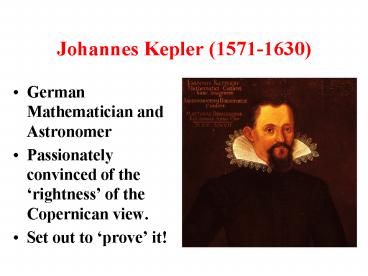Johannes Kepler 15711630 - PowerPoint PPT Presentation
1 / 26
Title: Johannes Kepler 15711630
1
Johannes Kepler (1571-1630)
- German Mathematician and Astronomer
- Passionately convinced of the rightness of the
Copernican view. - Set out to prove it!
2
Early Life and Values
- Studied at University of Tubingen
- Intended to be Lutheran Minister.
- .But got diverted into Astronomy!
- Devout Christian, who saw God as the Great
Geometer Pythagorian Tendencies - In 1594 moved to University of Graz, Austria as
mathematics and astronomer teacher.
3
Details of Keplers Mysterium
- The five regular solids of Antiquity
- Shape Sides
4
Keplers Mysterium1596
- Geometric Solar system of perfect solids
nested in spheres.
5
Mysterium Cosmographicum 1596
- Euclidean Geometry
- Only 5 regular solids that could be both
circumscribed and inscribed by spheres.
6
Keplers Emphasis
- Cosmical Mystery unashamedly Copernican.
- Sun was driving mechanism, as distant planets
travel slower. - Thats why there are only 6 planets!
- God is a mathematician!
- Pythagorean harmony and beauty.
- Seeking mechanism for the motion of planets, not
just charting them.
7
Kepler and Brahe (1600-1601)
- Tycho Brahes Assistant from 1600, while near
Prague. - Studied the problematical motion of Mars.
- Kepler promoted after Brahes untimely death to
Imperial Mathematicus to Rudolph II. - Acquired Tychos data after his death!
8
Incidentally Kepler andThe Star of Bethlehem
- In 1604 Kepler observed a brilliant conjunction
(a close apparent mutual approach) of Jupiter,
Saturn and Mars. - He calculated that this type of conjunction takes
place every 805 years. - Hence previously occurred in AD 799 and in
(February) 6 BC. - This is now regarded as the Star of Bethlehem.
9
Keplers Nova(1604)
Also seen by Galileo
Remnant as seen today
10
Keplers Astronomia Nova (1609)
Title page mentions both Tycho Brahe.and his
Patron, Emperor Rudolph.
11
Keplers Astronomia Nova (1609)
- Accurate data ultimate challenge to circular
motion. - Eventually discovered that ellipses would
dramatically describe the observations!
Marks the site of Keplers house while in Prague.
12
Keplers First Law
- The orbital paths of planets are elliptical
- (not circular) with the Sun at one focus.
Properties of conic sections known since
Apollonius and Euclid
13
Definition on an Ellipse
- Locus of points produced by this practical
geometric construction.
14
Property of an Ellipse
- Major and Minor axes
- Two Foci.
- The Sun is at one focus, the other is not
physically significant.
15
Comments on Elliptical Motion
- Elliptical motion No small achievement!
- Challenged the Authority of Aristotle.
- Except for Mercury (and Pluto) eccentricity is so
small cannot easily distinguish it from circular
motion. - Hence Ptolemaic and Copernican models did so well
for so long. - Galileo did not like ellipses!
16
Keplers Second Law(Though discovered First!)
- An imaginary line connecting the Sun to any
planet sweeps out equal areas in equal intervals
of time. - Planets therefore have different speeds at
perihelion and aphelion. - Challenges Aristotles insistence that planets
have a constant or uniform speed.
17
Keplers Second Law Visualised
- Red arcs all take the same time
- for equal areas A, B, C.
18
Keplers Harmonices Mundi 1619
- Never lost his admiration for Pythagorean
harmony. - Was aware of Gilberts Magnetism (1600)
- Seeking a causation for motion
- My aim is to show that the celestial machine is
to be likened not to a divine organism, but
rather to clockwork. Johannes Kepler
19
Keplers Third Law
- Laws (1) and (2) published in 1609, based on a
long study of the motion of Mars. - An appeal to simplicity in mathematics.
- During next 10 years extended to all known
planets and devised 3rd law. - The square of the planets orbital period is
proportional to the cube of its semi-major
axis. or P2/a3 Constant
20
Orbital Properties of the Planets
21
Further Notes
- Period is Sidereal period
- Astronomical Unit semi-major axis of the
Earths orbit - (or average Sun-Earth distance)
- Deviations in P2/a3 for Uranus and Neptune is
mutual gravitational effect. - Predictive Law .applies to all planets.
22
The Size of the Solar System
- Keplers 3rd Law (P2/a3 Constant) only gives
the relative scale of the solar system - Orbital periods known in terms of Earth years.
- Semi-major axis known in terms of that of the
Earth. - Need to determine the actual length of the
Astronomical unit (A.U.)..how? - Need reliable measure of the parallax when the
planet is closest to us (hence biggest
parallax)
23
Keplers Rudolphine Tables (1627)
- Pillars of Astronomy Hipparchus, Ptolemy,
Copernicus and Brahe - Most accurate planetary tables
- Significantly better than Copernican
Prutenic Tables
24
Keplers Rudolphine Tables (1627)
25
Reaction to Keplers Work
- Slow acceptance, despite certain religious
misgivings. - Ultimately his reliable Rudolphine Tables would
force people to recognize his achievements
but mainly after his death - Welcomed in England, Galileo sceptical.
- Increased emphasis on mechanism not teleology.
- Pivotal figure in challenging Aristotle.
26
Doppelmayer Celestial Atlas Frontispiece (1742)
- Ptolemy, Copernicus, Kepler and Brahe

